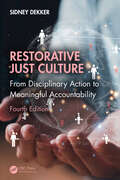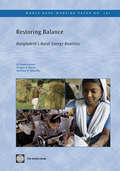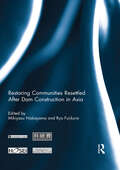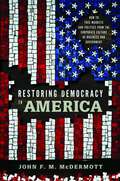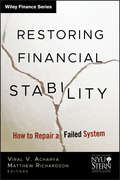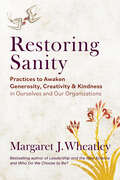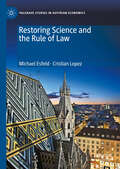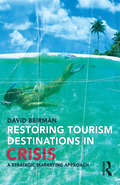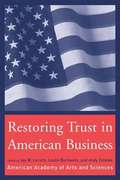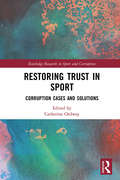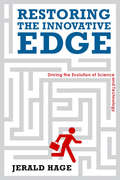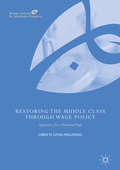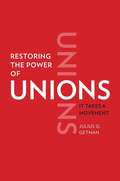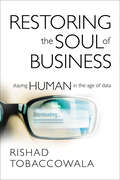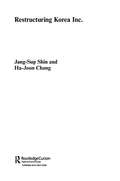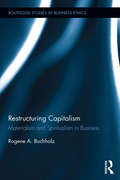- Table View
- List View
Restorative Just Culture in Practice: Implementation and Evaluation
by Sidney Dekker, Joseph Rafferty and Amanda OatesA restorative just culture has become a core aspiration for many organizations in healthcare and elsewhere. Whereas ‘just culture’ is the topic of some residual conceptual debate (e.g. retributive policies organized around rules, violations and consequences are ‘sold’ as just culture), the evidence base on, and business case for, restorative practice has been growing and is generating increasing, global interest. In the wake of an incident, restorative practices ask who are impacted, what their needs are and whose obligation it is to meet those needs. Restorative practices aim to involve participants from the entire community in the resolution and repair of harms. This book offers organization leaders and stakeholders a practical guide to the experiences of implementing and evaluating restorative practices and creating a sustainable just, restorative culture. It contains the perspectives from leaders, theoreticians, regulators, employees and patient representatives. To the best of our knowledge, there is no book on the market today that can function as a guide for the implementation and evaluation of a just and learning culture and restorative practices. This book is intended to fill this gap. This book will provide, among other topics, an overview of restorative just culture principles and practices; a balanced treatment of the various implementations and evaluations of just culture and restorative processes; a guide for leaders about what to stop, start, increase and decrease in their own organizations; and an attentive to philosophical and historical traditions and assumptions that underlie just culture and restorative approaches. The interest in ‘just culture’, not just in healthcare but also in other fields of safety-critical practice, has been steadily growing over the past decade. It is a trending area. In this, it has become clear that 20-year-old retributive models not only hinder the acceleration of performance and organizational improvement but have also in some cases become a blunt HR instrument, an expression of power over justice and a way to stifle honesty, reporting and learning. What is new in this, then, is the restorative angle on just culture, as it has been developed over the last few years and now is practised and applied to HR, suicide prevention, healthcare improvement, regulatory innovations and other areas.
Restorative Just Culture: From Disciplinary Action to Meaningful Accountability, Fourth Edition
by Sidney DekkerIn the world of work, accountability can often translate into punishment. This book explores trust, learning, and accountability in the aftermath of incidents. Fully updated, the fourth edition of Restorative Just Culture covers restorative justice, challenging conventional notions of blame and retribution to create a “just culture” in the workplace.Whether you’re grappling with the fallout of an incident or seeking to foster a culture of trust and compassion, this book offers invaluable insights and practical guidance. This fascinating title challenges the traditional concept of accountability and urges the reader to consider not just who broke the rules, but who was harmed and what their needs are. Written by a pioneer in the field, this book draws from extensive case studies and fresh insights. Through narratives and thought-provoking analysis, the author explores the transformative power of restorative justice and the complexities of human error in organizational settings. New to this edition are new chapters, updates to criminalizing human error, a section on forgiveness, coverage of implementing restorative justice in an organization and much more. The reader of this book can reevaluate how they see their workplace culture and how it can be made safer and fairer.Restorative Just Culture: From Disciplinary Action to Meaningful Accountability, Fourth Edition is a must-read for professionals in health and safety, business and management, and others with accountability in professional environments.
Restoring America's Rivers: The Movement for Dam Deconstructions and Rehabilitations
by Richard M. RobinsonThe undamming and restoration of rivers is a major component of our broader environmental movement. There are ecological, economic, and social justice issues enveloped by initiatives involving river restorations, and it’s time to focus our attention on these concerns. In this book, Richard M. Robinson reviews the removal of big concrete, big earthen, and low-head dams along North America’s larger and smaller rivers. Chapters highlight issues and contradictions related to dam safety, dam removals, and river restoration. The resulting book provides key insights into the economics and ecology of environmental restoration, our water resource management, and environmental justice.
Restoring Balance: Bangladesh's Rural Energy Realities
by Shahidur R. Khandker M. Asaduzzaman Douglas F. BarnesRural energy's importance to the Bangladesh economy cannot be underestimated, The problems rural people face in obtaining safe, clean, and reliable energy supplies are not minor inconveniences. People are cooking with biomass fuels including large amounts of leaves and grass that expose them harmful indoor air pollution. They light with kerosene or sometimes candles which give off a dim light that hampers studying and reading in the evening. Finally, rural productivity suffers because of lack of access to modern energy. However, the picture also is not all bleak. This study underscores how improved access to rural energy services can created multiple benefits for rural life-from income and labor productivity to education and women's health. Recommended or enhancement of programs for improved stoves, rural electrification, renewable energy and greater access to commercial liquid fuels can significantly improve both the rural productivity and enhance the quality of life in rural Bangladesh.
Restoring Communities Resettled After Dam Construction in Asia (Routledge Special Issues on Water Policy and Governance)
by Mikiyasu Nakayama and Ryo FujikuraThe rapid economic expansion and population growth of developing countries in Asia has led to increasing demands for water and energy. To meet these demands, large dam development projects have been completed, which has inevitably caused involuntary resettlement. In order to support these projects, dam developers must find appropriate ways to ensure adequate livelihood reconstruction for resettled individuals. Resettlement causes both short-term and long-term effects (both positive and negative) for the relocated populations, meaning that in order to evaluate the larger impact of such projects long-term post-project evaluations must be carried out. However, post-project evaluations by international donors have typically been conducted within a few years after completion; the long-term impact of such projects is seldom evaluated.This book aims to fill this gap. A study team composed of researchers from Indonesia, Japan, Lao PDR, Sri Lanka, and Turkey has conducted ten case studies focusing on resettled individuals satisfaction, opportunities offered, and income generation. The volume provides an overview of the ten case studies, which were carried out across five countries. It also discusses how a compensation programme should be designed and what sort of options should be presented to resettled individuals for their maximum benefit.This book was originally published as a special issue of the International Journal of Water Resources Development.
Restoring Democracy to America: How to Free Markets and Politics from the Corporate Culture of Business and Government
by John F. McDermottIf the current economic malaise accomplishes nothing else, it should help awaken us all to the realization that our country has been on a path of self-destructive behavior for several decades—a reversal of the progressive path that had made major gains in economic and political equality for a large majority of the U.S. population starting in the 1870s. It is John McDermott’s purpose in this ambitious book to explain why that reversal happened, how society has changed in dramatic ways since the 1960s, and what we can do to reverse this downward spiral. In Part 1 he endeavors to lay out the overall narrative of change from the 1960s to the present, emphasizing how a novel social structure came to be developed around corporate America to form what he calls “corporate society.” Part 2 analyzes what the nature of this corporate society is, how it is a special type of “fabricated” structure, and why it came to dominate society generally, eventually including the government and university systems, which themselves became increasingly corporatized. The aim of Part 3 is to outline a path of reform that can, if all its parts can be integrated sufficiently to be effective, put us on the path to restarting the progressive movement.
Restoring Financial Stability: How to Repair a Failed System (Wiley Finance #542)
by Matthew Richardson Viral Acharya New York University Stern School of BusinessAn insightful look at how to reform our broken financial systemThe financial crisis that unfolded in September 2008 transformed the United States and world economies. As each day's headlines brought stories of bank failures and rescues, government policies drawn and redrawn against the backdrop of an historic Presidential election, and solutions that seemed to be discarded almost as soon as they were proposed, a group of thirty-three academics at New York University Stern School of Business began tackling the hard questions behind the headlines. Representing fields of finance, economics, and accounting, these professors-led by Dean Thomas Cooley and Vice Dean Ingo Walter-shaped eighteen independent policy papers that proposed market-focused solutions to the problems within a common framework. In December, with great urgency, they sent hand-bound copies to Washington. Restoring Financial Stability is the culmination of their work.Proposes bold, yet principled approaches-including financial policy alternatives and specific courses of action-to deal with this unprecedented, systemic financial crisisCreated by the contributions of various academics from New York University's Stern School of BusinessProvides important perspectives on both the causes of the global financial crisis as well as proposed solutions to ensure it doesn't happen againContains detailed evaluations and analyses covering many spectrums of the marketplaceEdited by Matthew Richardson and Viral Acharya, this reliable resource brings together the best thinking of finance and economics from the faculty of one of the top universities in world.
Restoring Our Sanity Online: A Revolutionary Social Framework
by Mark Weinstein“This is a must-read for anyone concerned with where we are today and looking for a better path forward.” ―Steve Wozniak, Co-founder, Apple Inc. Big Tech is driving us, our kids, and society mad. In the nick of time, Restoring Our Sanity Online presents the bold, revolutionary framework for an epic reboot. What would social media look like if it nourished our critical thinking, mental health, privacy, civil discourse, and democracy? Is that even possible? Restoring Our Sanity Online is the entertaining, informative, and frequently jaw-dropping social reset by Mark Weinstein, contemporary tech leader, privacy expert, and one of the visionary inventors of social networking. This book is for all of us. Casual and heavy users of social media, parents, teachers, students, techies, entrepreneurs, investors, and elected officials. Restoring Our Sanity Online is the catapult to an exciting, enriching, and authentic future. Readers will embark on a captivating journey leading to an inspiring and actionable reinvention. Restoring Our Sanity Online includes thought-provoking insights including: Empowering You—Social Media User, Content Creator In The Crosshairs: Privacy And Anonymity Saving Our Kids From The Abyss Surprise! Social Media Can Be Good For Your Mental Health Is AI The High-Tech Tattletale In Your Social Experience? Lifting the Veil On Bots and Trolls Facts, Opinions, Lies—Who Decides? Web3 Is Here—What The Heck Is It? Is There a Better Way?
Restoring Sanctuary: A New Operating System for Trauma-Informed Systems of Care
by Sandra L. Bloom Brian FarragherThis is the third in a trilogy of books that chronicle the revolutionary changes in our mental health and human service delivery systems that have conspired to disempower staff and hinder client recovery. Creating Sanctuary documented the evolution of The Sanctuary Model therapeutic approach as an antidote to the personal and social trauma that clients bring to child welfare agencies, psychiatric hospitals, and residential facilities. Destroying Sanctuary details the destructive role of organizational trauma in the nation's systems of care. Restoring Sanctuary is a user-friendly manual for organizational change that addresses the deep roots of toxic stress and illustrates how to transform a dysfunctional human service system into a safe, secure, trauma-informed environment.
Restoring Sanity: Practices to Awaken Generosity, Creativity, and Kindness in Ourselves and Our Organizations
by Margaret J. WheatleyWhat Would It Be Like to Restore Sanity? What would it be like to work together again in creative and generous ways? What would it be like to be curious about who you're with rather than judging or fearing them? What would it be like to engage together in exploring possibilities rather than withdrawing in conflict or disagreement? What would it be like to be working well together?From 50 years working with leaders globally, I state with full confidence that leadership has never been more difficult. And it's not our fault. We've been good and caring leaders, we've led people in empowering, engaging ways to create meaningful, productive work. But now we face external conditions far beyond our control to change, dynamics intensifying at shocking speed.The perfect storm is here, created by the coalescence of climate and human-created catastrophes. As leaders dedicated to serving the causes and people we treasure, confronted by this unrelenting tsunami, what are we to do? I state my answer to this also with full confidence:We need to restore sanity by awakening the human spirit. We can achieve this only if we undertake the most challenging and meaningful work of our leader lives: Creating Islands of Sanity.An Island of Sanity is a gift of possibility and refuge created by people's commitment to form healthy community to do meaningful work. It requires sane leaders with unshakable faith in people's innate generosity, creativity, and kindness. It sets itself apart as an island to protect itself from the life-destroying dynamics, policies, and behaviors that oppress and deny the human spirit. No matter what is happening around us, we can discover practices that enliven our human spirits and produce meaningful contributions for this time.
Restoring Science and the Rule of Law (Palgrave Studies in Austrian Economics)
by Michael Esfeld Cristian LopezScience and the rule of law are the two pillars of modernity. Even though both result from the attempt to employ reason to limit the exercise of power in the scientific and the political sphere, they bear in themselves the germs of their own destruction: scientism and welfare totalitarianism. This book examines a trend towards a new, specifically postmodern totalitarianism, namely a regime of “actually existing postmodernism” that is based on the collusion of four elements: (i) scientism and its political use, (ii) intellectual postmodernism, (iii) welfare states, and (iv) crony capitalism. The book then shows a way out by utilising the philosophy of Descartes and Kant, the social-normative turn in the 20th century, and the resources of Austrian libertarianism from Hayek and Popper to Mises, Rothbard and Hoppe. These intellectual resources lay the ground for a New Enlightenment and an open society shaped by a free science and voluntary cooperation under the rule of law. Restoring Science and the Rule of Law is essential reading for philosophers of science and for political theorists interested in the foundations of the rule of law.
Restoring Tourism Destinations in Crisis: A strategic marketing approach (Cabi Publishing Ser.)
by David BeirmanThis is an outstanding book. It offers a comprehensive range of in-depth case studies that looks at past tourism crisis and analyzes the responses made. A must-read book for those in the industry, related associations and the various levels of government as they consider how to pro-actively deal with the potential for future crisis related to tourism.Perry Hobson, Head, School of Tourism and Hospitaliy Management, Southern Cross University and Editor-in-Chief Journal of Vacation Marketing.Tourism everywhere is vulnerable to changes in public perception. When news about an earthquake, a violent conflict or a contagious disease in a distant location hits the television, tourists cancel holidays.The September 11, 2001 terrorist attack against the USA impacted on airlines and tourist destinations worldwide, as did subsequent attacks on tourists. These events highlight the importance of destination crisis management for the global tourism industry. Experienced tourism marketer and trainer, David Beirman, has created a guide to crisis management for tourism operators and offices. He argues that managing public perception is critical to the recovery of a destination after a crisis, and that much depends on providing clear, frequently updated and accurate information. He provides detailed case studies of different types of crises from around the world, with analyses of the strengths and weaknesses of the approach taken by tourism managers.This is an invaluable reference for tourism managers anywhere in the world, and a useful resource for tourism students.
Restoring Trust at WorldCom
by Jay W. Lorsch Ashley C. RobertsonExamines the changes in corporate governance at WorldCom/MCI as proposed by the company's court-appointed corporate monitor, Richard Breeden. Following the largest bankruptcy ever and the downfall of the company, Breeden wrote "Restoring Trust," a report comprised of 78 recommendations for the future governance of the company. Teaching Purpose: To think about how to improve corporate governance at a specific company.
Restoring Trust in American Business
by Jay William Lorsch Martin Lipton Larry W. Sonsini Leslie Berlowitz Andy ZellekeRecent business scandals point to a disturbing breakdown of values in corporate America. This book responds to the crisis by examining the responsibilities of "gatekeepers"--corporate directors, regulators, auditors, lawyers, investment bankers, and business journalists--who stand between corporate misconduct and the public. The essays, by prominent scholars and practitioners, argue that market pressures have made gatekeepers too focused on financial self-interest and too heedless of the public good to live up to society's legitimate expectations. A key part of the book is a set of recommendations for enhancing gatekeeper professionalism. These range from specific steps for improving boards of directors to a call for the investment banking community to establish a uniform code of conduct and articulate its obligations to the investing public. This book grew out of the Corporate Responsibility Project undertaken by the American Academy of Arts and Sciences. The contributors come from institutions ranging from Wall Street and the nation's leading law and business schools to the AFL-CIO; they include such prominent figures as John S. Reed of the New York Stock Exchange, investment banker Felix Rohatyn, corporate lawyer Martin Lipton, and media commentator and professor of journalism Geneva Overholser.
Restoring Trust in Sport: Corruption Cases and Solutions (Routledge Research in Sport and Corruption)
by Catherine OrdwayIn this solutions-focused collection of sport corruption case studies, leading researchers consider how to re-establish trust both within sports organisations and in the wider sporting public. Inspired by the idea of ‘moral repair’, the book examines significant corruption cases and the measures taken to reduce further harm or risk of recurrence. The book has an international scope, including case study material from Europe, Asia, Africa, Australia and New Zealand, and covers important contemporary issues including whistleblowing, bribery, match-fixing, gambling, bidding for major events, and good governance. It examines the loss of trust at both national and international levels. Drawing on cutting-edge research, the book includes both on-field and off-field examples, from Olympic, non-Olympic, professional and amateur sports, as well as diverse academic and practitioner perspectives. Offering an important contribution to current debates and a source of reflection on best professional practice, Restoring Trust in Sport helps us to better understand why corruption happens in sport and how it can and should be addressed. This is invaluable reading for all advanced students, researchers, managers and policy makers with an interest in integrity in sport, sport ethics, sport management, sport governance, sports law, and a useful reference for anybody working in criminology, business and management, law, sociology or political science.
Restoring the American Dream
by Robert Ringer Stephen MooreCompletely updated edition of one of the classic works of conservative literature Long before the advent of conservative talk radio and Fox News, Robert Ringer was an outspoken advocate for the cause of freedom and free enterprise. In this classic work-updated for the 21st century-Ringer's basic premise is that liberty must be given a higher priority than all other objectives. The economic and political calamity that he warned about in the late seventies is now upon us, and his new edition of Restoring the American Dream is sure to resonate with the feelings of today's angry voters. In his book, Ringer explains that: * The American Dream is not about increased government benefits and government-created "rights," but, rather, about individualism, self responsibility, and freedom-including the freedom to succeed or fail on one's own * The barbarians are not at the gates; they are already inside * Ordinary citizens no longer tell their elected officials what to do. Rather, government tells them what to do-and backs it up with force * The desire of people to band together to bring about quick, short term solutions to their problems through government intervention has perpetuated a cycle that has nearly destroyed the American Dream With Washington continuing to expand government power and spending at a record pace, Restoring the American Dream is a voice of sanity in a world gone mad.
Restoring the Innovative Edge
by Jerald HageConsiderable evidence indicates that the U. S. is falling behind when it comes to innovation. In part, this shift stems from the globalization of research and the advancement of other nations. But, it also arises from a widespread failure to adapt to the competitive environment generated by the evolution of science and technology. The objective of this book is to provide possible remedies for eight key obstacles that the U. S. faces in restoring its innovative edge. Understanding that these remedies are complex, each chapter also discusses the dilemmas and impediments that make change a challenge. Unlike other books that suggest simple fixes to the U. S. innovation crisis, this book argues that the management of innovation requires multiple interventions at four different levels: in research teams, organizations, economic and non-economic sectors, and society at large. Restoring the Innovative Edgeoffers specific recommendations for new forms of data collection, fresh ideas about cooperation between the public and the private sectors in manufacturing research, and a policy evaluation model that measures technical progress-and obstacles to it-in real time. Moreover, the book's multi-level perspective allows for the integration of a number of specialties within Sociology and Management around the theme of a new socio-economic paradigm, built on ideas of evolution and failed evolution.
Restoring the Middle Class through Wage Policy: Arguments For A Minimum Wage (Binzagr Institute For Sustainable Prosperity Ser.)
by Oren M. Levin-WaldmanThis book delivers a fresh and fascinating perspective on the issue of the minimum wage. While most discussions of the minimum wage place it at the center of a debate between those who oppose such a policy and argue it leads to greater unemployment, and those who favor it and argue it improves the economic well-being of low-income workers, Levin-Waldman makes the case for the minimum wage as a way to improve the well-being of middle-income workers, strengthen the US economy, reduce income inequality, and enhance democracy. Making a timely and original contribution to the defining issues of our time—the state of the middle class, the problem of inequality, and the crisis of democratic governance—Restoring the Middle Class through Wage Policy will be of interest to students and researchers considering the impact of such approaches across the fields of public policy, economics, and political science.
Restoring the Power of Unions: It Takes a Movement
by Julius G. GetmanThe labor movement is weak and divided. Some think that it is dying. But Julius Getman, a preeminent labor scholar, demonstrates through examination of recent developments that a resurgent labor movement is possible. He proposes new models for organizing and innovating techniques to strengthen the strike weapon. Above all, he insists that unions must return to their historical roots as a social movement.
Restoring the Soul of Business: Staying Human in the Age of Data
by Rishad TobaccowalaFrom old-fashioned bricks-and-mortars to cutting-edge startups, businesses are moving into uncharted territory as they determine how to move from an analog past to a digital future effectively. How can you make sure not to leave human instinct behind?Businesses are leaving behind traditional meetings in favor of virtual ones, transitioning from surveys and studies to analytics and algorithms. The startling and often unacknowledged truth is that?the promise of digital transformation can only be realized when we find a way to balance it with the promise of people.?In the end, it&’s the people that matter, and companies must never forget the soul that drives them.In Restoring the Soul of Business, business leader Rishad Tobaccowala?teaches you to: Understand how to unleash the significant benefit that can be realized by combining emotion and data, human and machine, analog and digital.Spot the warning signs of data-blinded companies: cold cultures with little human interaction, poor innovation stemming from discouraged employees who don&’t contribute ideas, and poor customer service due to automated, robotic processes.Explore how organizations of various sizes and from different industries have successfully reoriented their thinking on how to fuse technology and humanity.Gain skills to become an expert in connections critical to growth and success, including the connection between being creative and using technology.Everyone working in an organization will find penetrating observations and guidance about how and why establishing the proper balance between human intuition and creativity and data-driven insights can lead to increased revenue, profitability, retention—and even joy—in their careers and business.Restoring the Soul of Business provides practical tools and techniques that every organization can and should implement, and challenges you to move forward with the kind of balance that capitalizes transformation and produces one great success after another.
Restructure or Reconfigure?
by Samina Karim Stephane J.G. Girod"The Problem Companies must reorganize periodically to keep pace with changes in market conditions. But executives grapple with conflicting advice about whether, when, and how to do so. The Research The term “reorganization” encompasses two distinct change processes: restructuring and reconfiguration. Each delivers value if pursued in the right way. Over the past three decades, the authors have examined how each type affects organizational processes and performance. The Recommendation To choose the right reorganization at the right time, follow these guidelines: Tailor the reorg to your circumstances, change at the right pace, play to your strengths, and determine what other systems need to change, too."
Restructuring 'Korea Inc.': Financial Crisis, Corporate Reform, and Institutional Transition (Routledge Studies In The Growth Economies Of Asia Ser. #Vol. 42)
by Ha-Joon Chang Jang-Sup ShinThe 1997 South Korean financial crisis not only shook the country itself but also sent shock waves through the financial world at large. This impressive book critically assesses the conventional wisdom surrounding the Korean crisis and the performance of the IMF-sponsored reform programme.Looking first at the strengths and weaknesses of 'Korea Inc.
Restructuring Bulong's Project Debt
by Michael Kane Benjamin C. EstyPreston Resources, a small Australian gold mining company, bought the Bulong nickel mine for A$319 million in November 1998 and financed the acquisition by issuing a US$185 million (A$294 million) project bond. At the time, mining had been underway for several months, and construction of the processing plant was essentially complete. Almost from the beginning, however, a series of design and operating problems shut down production and required costly repairs. Although processing performance improved by late 2000, maintenance issues continued to plague the plant, and output remained significantly below forecast levels. This case, set in 2002, concerns the financial consequences of these problems, including a bond default in January 2000 and Preston's efforts to restructure the project debt.
Restructuring Capitalism: Materialism and Spiritualism in Business (Routledge Studies in Business Ethics)
by Rogene BuchholzThe main theme of this book is that, within contemporary capitalist societies a materialist outlook informed by science has triumphed creating the lack of a spiritual dimension to give meaning and purpose to the activities that are necessary for a capitalist society to function effectively. Capitalist societies are in trouble and need to be restructured to provide for the material needs of all the people who work within the system, not just the one percent, but because of the lack of a spiritual connection with each other and with nature this is not likely to happen. It has been said that society and the organizations within treat one another as objects to be manipulated in the interests of promoting economic growth and treat nature as an object to be exploited for the same purpose. This way of treating each other, and nature, is consistent with the way a capitalist system has worked in the past and was supposed to enable it to function efficiently to provide a fulfilling and enriched life for all its adherents through growth of the economy. However, as capitalist societies have become dysfunctional they will need a different kind of orientation to continue in existence. Restructuring Capitalism: Materialism and Spiritualism in Business argues that what is needed is a new sense of a spiritualization of the self and its relation to others and to the establishment of a spiritual connection with nature in order for capitalism to be restructured to work for everyone and for the society as a whole.
Restructuring Distressed Companies-Cross National Comparisons
by William E. FruhanThis note describes briefly bankruptcy regimes and out of court restructuring in 5 countries, the U.S., the U.K., Germany, France and Japan.

